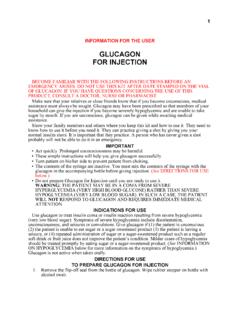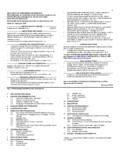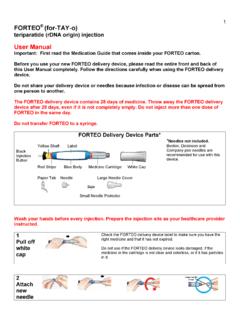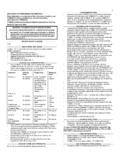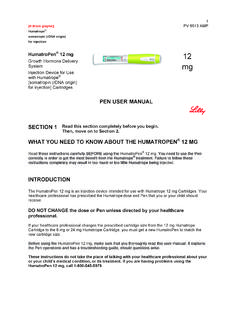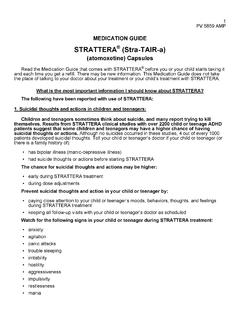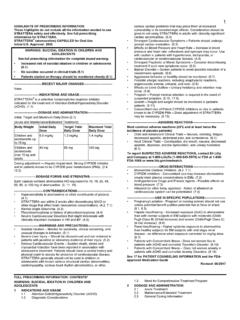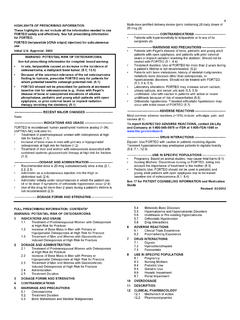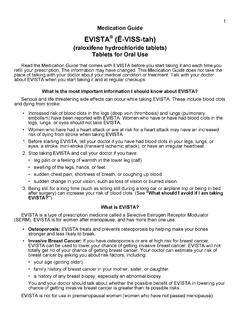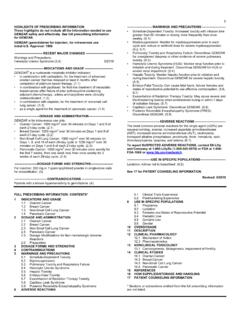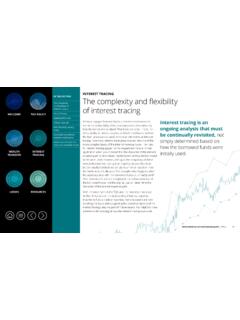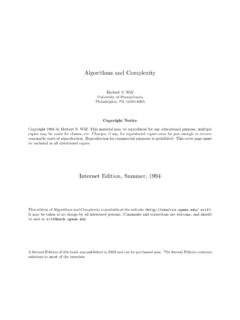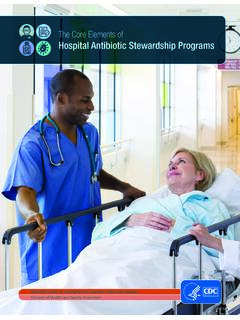Transcription of FACT SHEET FOR HEALTH CARE PROVIDERS EMERGENCY USE ...
1 FACT SHEET FOR HEALTH CARE PROVIDERS . EMERGENCY USE AUTHORIZATION (EUA) OF BAMLANIVIMAB AND. ETESEVIMAB. AUTHORIZED USE. TREATMENT. The Food and Drug Administration (FDA) has issued an EMERGENCY Use Authorization (EUA) to permit the EMERGENCY use of the unapproved products bamlanivimab and etesevimab administered together for the treatment of mild to moderate coronavirus disease 2019 (COVID-19) in adults and pediatric patients, including neonates, with positive results of direct SARS-CoV-2 viral testing, and who are at high risk for progression to severe COVID-19, including hospitalization or death. limitations of Authorized Use Bamlanivimab and etesevimab are not authorized for treatment of mild to moderate COVID-19 in geographic regions where infection is likely to have been caused by a non-susceptible SARS-CoV-2 variant based on available information including variant susceptibility to these drugs and regional variant frequency.
2 O FDA's determination and any updates will be available at: regulatory-and-policy-framework/emergenc y-use- authorization#coviddrugs. 1. Bamlanivimab and etesevimab are not authorized for use in patients 2 years and older who are hospitalized due to COVID-19. 2. Bamlanivimab and etesevimab are not authorized for use in patients, regardless of age, who: o require oxygen therapy and/or respiratory support due to COVID-19, OR. o require an increase in baseline oxygen flow rate and/or respiratory support due to COVID-19 and are on chronic oxygen therapy and/or respiratory support due to underlying non-COVID-19 related comorbidity. Treatment with bamlanivimab and etesevimab has not been studied in patients hospitalized due to COVID-19. Monoclonal antibodies, such as bamlanivimab and etesevimab, may be associated with worse clinical outcomes when administered to hospitalized patients with COVID-19 requiring high flow oxygen or mechanical ventilation.
3 1 FDA will monitor conditions to determine whether use in a geographic region is consistent with this scope of authorization, referring to available information, including information on variant susceptibility [see Microbiology/Resistance Information (15)], and CDC regional variant frequency data available at: #variant-proportions. 2 The reasons for hospital admission may be different and the threshold for hospital admission may be lower for neonates, young infants and toddlers with COVID-19 compared to older children and adults. The authorization allows for young children ( , birth to 2 years of age) who are hospitalized with mild to moderate COVID-19 at the time of treatment to receive bamlanivimab and etesevimab. 1. POST-EXPOSURE PROPHYLAXIS. The Food and Drug Administration (FDA) has issued an EMERGENCY Use Authorization (EUA) to permit the EMERGENCY use of the unapproved products bamlanivimab and etesevimab administered together in adults and pediatric individuals, including neonates, for post-exposure prophylaxis of COVID-19 in individuals who are at high risk of progression to severe COVID-19, including hospitalization or death, and are.
4 Not fully vaccinated 3 or who are not expected to mount an adequate immune response to complete SARS-CoV-2 vaccination (for example, individuals with immunocompromising conditions including those taking immunosuppressive medications 4) and o have been exposed to an individual infected with SARS-CoV-2 consistent with close contact criteria per Centers for Disease Control and Prevention (CDC) 5 or o who are at high risk of exposure to an individual infected with SARS-CoV- 2 because of occurrence of SARS-CoV-2 infection in other individuals in the same institutional setting (for example, nursing homes, prisons) [see limitations of Authorized Use ( )]. limitations of Authorized Use Bamlanivimab and etesevimab are not authorized for post-exposure prophylaxis of COVID-19 in geographic regions where exposure is likely to have been to a non- susceptible SARS-CoV-2 variant, based on available information including variant susceptibility to these drugs and regional variant frequency.
5 O FDA's determination and any updates will be available at: regulatory-and-policy-framework/emergenc y-use- authorization#coviddrugs. 6. Post-exposure prophylaxis with bamlanivimab and etesevimab is not a substitute for vaccination against COVID-19. Bamlanivimab and etesevimab are not authorized for pre-exposure prophylaxis for prevention of COVID-19. 3 Individuals are considered to be fully vaccinated 2 weeks after their second vaccine dose in a 2-dose series (such as the Pfizer or Moderna vaccines), or 2 weeks after a single-dose vaccine (such as Johnson &. Johnson's Janssen vaccine). See this website for more details: ncov/ #vaccinated. 4 See this website for more details: 5 Close contact with an infected individual is defined as: being within 6 feet for a total of 15 minutes or more, providing care at home to someone who is sick, having direct physical contact with the person (hugging or kissing, for example), sharing eating or drinking utensils, or being exposed to respiratory droplets from an infected person (sneezing or coughing, for example).
6 See this website for additional details: 6 FDA will monitor conditions to determine whether use in a geographic region is consistent with this scope of authorization, referring to available information, including information on variant susceptibility [see Microbiology/Resistance Information (15)], and CDC regional variant frequency data available at: #variant-proportions. 2. RECENT MAJOR CHANGES. limitations of Authorized Use updated limitations of Revised 01/2022. Authorized Use for treatment and post-exposure prophylaxis. limitations of Authorized Use (Section 1 and Box) Revised 12/2021. removal of the limitations of Authorized Use related to resistant variants and modification of SARS-CoV-2 viral variant section of the Box. Antiviral Resistance (Box and Section 15) addition of Revised 12/2021, information on susceptibility of SARS-CoV-2 variants to 08/2021, 05/2021, bamlanivimab and etesevimab (Table 5 and Table 6) and and 03/2021.
7 Updates based on latest viral surveillance report and additional sequencing data from Phase 3 study PYAB. Information to Support Expansion of Pediatric Use (Box, Revised 12/2021. Section 1, Section , Section , Section , and Section ) pediatric patients from birth to <12 years of age. How Supplied/Storage and Handling (Section 19) Revised 12/2021. addition of information related to the extension of expiry date of bamlanivimab and etesevimab. Authorized Use (Box and Section 1) addition of new Revised 09/2021. indication for post-exposure prophylaxis of COVID-19. Clinical Trial Results and Supporting Data for EUA, Post- Revised 09/2021. Exposure Prophylaxis of COVID-19 (BLAZE-2) (Section ) addition of Phase 3 data for the authorized use. Authorized Use (Box and Section 1) expanded the Revised 08/2021. definition of progression of severe COVID-19 to include death. limitations of Authorized Use (Section 1) change to Revised 08/2021.
8 Authorized use related to the combined frequency of SARS-CoV-2 variants that are resistant to bamlanivimab and etesevimab. Warnings: Hypersensitivity Including Anaphylaxis and Revised 08/2021. Infusion-Related Reactions (Section ) addition of vasovagal reactions. Warnings: Clinical Worsening After Bamlanivimab and Revised 08/2021. Etesevimab Administration (Section ) updated to include administration with both antibodies. Definition of High Risk for Disease Progression (Box and Revised 05/2021. Section ) definition has been expanded to include additional medical conditions and other factors. Dosage and Administration, Dosage (Section ) Revised 05/2021. removal of rationale for authorized dose because Phase 3. data have confirmed the authorized dose. Overall Safety Summary, Clinical Trials Experience Revised 05/2021. (Section ) updated to integrated clinical trial safety analyses focused on adverse reactions and most common treatment-emergent adverse events.
9 3. Clinical Trial Results and Supporting Data for EUA, Mild to Revised 05/2021. Moderate COVID-19 (BLAZE-1) (Section ) addition of Phase 3 data for the authorized dose. Bamlanivimab and etesevimab have been authorized by FDA for the EMERGENCY uses described above. Bamlanivimab and etesevimab are not FDA-approved for these uses. Bamlanivimab and etesevimab are authorized only for the duration of the declaration that circumstances exist justifying the authorization of the EMERGENCY use of bamlanivimab and etesevimab under section 564(b)(1) of the Act, 21 360bbb- 3(b)(1), unless the authorization is terminated or revoked sooner. Treatment This EUA is for the use of the unapproved products bamlanivimab and etesevimab administered together for the treatment of mild to moderate COVID- 19 in adults and pediatric patients, including neonates, with positive results of direct SARS-CoV-2 viral testing, and who are at high risk for progression to severe COVID-19, including hospitalization or death [see limitations of Authorized Use ( )].
10 For treatment of COVID-19, bamlanivimab and etesevimab should be administered together as soon as possible after positive results of direct SARS-CoV-2 viral testing and within 10 days of symptom onset. Post-Exposure Prophylaxis This EUA is for the use of the unapproved products bamlanivimab and etesevimab administered together in adults and pediatric individuals, including neonates, for post-exposure prophylaxis of COVID-19 in individuals who are at high risk for progression to severe COVID-19, including hospitalization or death, and are: not fully vaccinated 7 or who are not expected to mount an adequate immune response to complete SARS-CoV-2 vaccination (for example, individuals with immunocompromising conditions including those taking immunosuppressive medications 8) and have been exposed to an individual infected with SARS-CoV-2. consistent with close contact criteria per Centers for Disease Control and Prevention (CDC) 9 or 7 Individuals are considered to be fully vaccinated 2 weeks after their second vaccine dose in a 2-dose series (such as the Pfizer or Moderna vaccines), or 2 weeks after a single-dose vaccine (such as Johnson &.)
